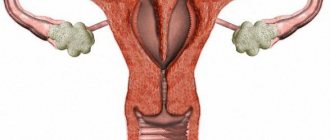Cold is not the best friend for our health, although in itself it is harmless. If a woman freezes, her body’s defenses invariably drop. Due to a sharp decrease in immunity, the uterine appendages may become infected, which becomes the cause of the inflammatory process.
It is especially dangerous to catch a cold in the ovaries, because the small gonads are an important part of the female reproductive system. In addition to extremely unpleasant symptoms, cold ovaries also threaten very serious consequences, the most serious of which is infertility.
Symptoms of inflammation of the appendages
Each woman has individual differences in the manifestations of sexual diseases.
You need to worry if you yourself notice any changes - unpleasant sensations, a strange smell, unusual discharge for you during menstruation or between them.
In all such cases, we recommend that you consult a gynecologist - symptoms that are not too disturbing may be harbingers of serious diseases, including inflammation of the uterine appendages - adnexitis.
Most often, women experience the following symptoms of colds in the ovaries and fallopian tubes:
- aching, “pulling” pain in the lower abdomen, as well as in the lower back, less often in the inner thigh;
- change in the nature of the discharge - the color becomes yellowish, the smell may be unpleasant;
- The amount of vaginal discharge may also change;
- Dialysis is often disrupted - urination becomes more frequent;
- the menstrual cycle may also be disrupted;
- general weakness bothers me;
- During acute inflammation, the body temperature reaches 38-39 C; during chronic inflammation, it can remain at a normal level.
Diagnosis of the disease
As a rule, diagnosing this disease does not cause any difficulty for doctors. An important role is played by the correct collection of anamnesis from the victim and the presence of characteristic complaints.
In order not to make a mistake in making a diagnosis, the girl must undergo the following examinations:
- Examination on the chair. Using a bimanual examination, the gynecologist “sees” an enlarged gonad. Often a woman reacts painfully when pressing on the affected organ.
- Ultrasound. On the screen, the doctor will see an enlarged ovary. Also, purulent formations, if present, and inflammatory changes in other reproductive organs will be noticeable.
- Hysterosalpingography. A diagnostic procedure consisting of an x-ray of the uterus and fallopian tubes with the introduction of a contrast agent. It is carried out if a woman’s adnexitis has become chronic. Using this study, it is possible to determine the patency of the fallopian tubes, eliminating this cause of infertility.
- Taking the tank. culture of vaginal discharge. The analysis will show whether pathogenic microorganisms are present in the woman’s vagina.
- Complete blood count (CBC). If there is a focus of inflammation in the body, then the analysis will show increased ESR and leukocytes.
- General urinalysis (UCA). TAM is able to show the presence of protein, red blood cells, leukocytes and various bacteria that should not normally be present.
Pashkova Alla Valerievna
Obstetrician-gynecologist, candidate of medical sciences.
Ask a Question
If adnexitis occurs with complications after hypothermia, the gynecologist may additionally prescribe tomography (CT or MRI) and endoscopic or X-ray examination of neighboring organs.
Diagnostics
To make a diagnosis, only complaints and external symptoms of an ovarian cold are not enough - laboratory tests are required. This is necessary in order to exclude diseases such as inflammation of the endometrium of the uterus (endometriosis), polycystic ovary syndrome, etc., which, naturally, require completely different treatment.
Laboratory diagnostics includes the following studies:
- Clinical blood test. Indicators such as ESR, leukocyte count, etc. increase with inflammation.
- Clinical urine analysis. This analysis will make it possible to distinguish inflammation of the kidneys from inflammation of the appendages, because with both of these diseases the lower back hurts, urination becomes more frequent, etc.
- Urogenital smear microscopy is a method for visually identifying bacteria inhabiting the vagina, cervical canal and urethra.
- Ultrasound allows you to exclude ectopic pregnancy, cysts and neoplasms of the internal genital organs.
The doctor will recommend that you undergo those studies that are indicative in your case.
Cold ovaries: symptoms, causes, treatment, folk methods
If a woman has a cold in her ovaries, the symptoms of inflammation or, as most people call it, “colds” of the appendages are pronounced and cause considerable discomfort. Even in childhood, girls are taught to wear warm pants in cool weather and never sit in cold weather.
But it often happens that the disorder appears suddenly, and the woman is not even aware of the true causes. Moreover, many people confuse the symptoms of serious diseases, suggesting that this is just short-term pain from cold ovaries.
In this article we will find out what an ovarian cold is, what its first manifestations are, its causes, and whether the disease can be cured at home.
Causes
Ovarian cold is an inflammatory process (oophoritis), which can spread to the fallopian tubes (adnexitis), uterus and, if untreated, causes infertility. ARVI is not the main cause of this disease.
During a viral infection, the body is weakened and susceptible to bacteria. Thus, gonococci, staphylococci, gonococci, and chlamydia provoke the development of ovarian colds in women.
However, gynecologists have identified several more factors that contribute to the onset of the disease:
- constant stress, depressed mood, nervousness, hysteria;
- psycho-emotional fatigue, depression;
- lack of rest, lack of sleep, insomnia;
- unbalanced diet, lack of vitamins, overeating or, conversely, malnutrition;
- obesity/anorexia;
- previous acute viral diseases (flu, sore throat, etc.);
- taking antibiotics;
- chronic diseases of the pelvic organs;
- hypothermia;
- wearing tight, tight underwear;
- abortion;
- incorrect installation of the intrauterine device;
- surgical interventions;
- unprotected sex, frequent change of sexual partners.
Even the most ordinary swimming in cool water, taking a cold shower or wearing a wet swimsuit for a long time contribute to the development of ovarian colds.
Types of cold appendages
As mentioned earlier, in medicine, a cold of the ovaries is called “oophoritis.” The disease manifests itself differently in each woman and depends on the severity and form of inflammation. So, the following types of oophoritis are distinguished:
- Spicy.
- Chronic.
- Subacute.
Most often, girls and women aged 18-30 are susceptible to the disease.
Symptoms
Painful sensations during ovarian colds usually appear much later than the moment of infection or are completely hidden.
Symptoms of an ovarian cold:
- nagging, aching, stabbing pain on one side of the lower abdomen (unilateral inflammation) or simultaneously on both sides (bilateral);
- pain radiates to the leg, lower back, tailbone, rectum;
- unusual discharge or “spotting”;
- disturbance of the menstrual cycle, sometimes urination and defecation;
- weakness, cold sweat.
Attention! There are many cases when a gynecologist, due to his unprofessionalism, confuses this type of cold of the appendages with appendicitis!
- pain in the ovarian area during or after sex;
- appearance of low-grade fever (37-37.5°C);
- painful ovulation and menstruation;
- purulent discharge with a pungent odor;
- dull pain in the lower abdomen, radiating to the lower back.
Signs of chronic ovarian colds most often appear before and during menstruation.
- sharp, acute pain in the ovarian area that does not go away after taking painkillers;
- general weakness, malaise, dizziness;
- body temperature 38.5-39°C;
- nausea, vomiting;
- painful urination, diarrhea or, conversely, constipation;
- copious unusual discharge.
Remember! With an ovarian cold, symptoms may not appear for a long time. If a possible violation is suspected (for example, if there has previously been hypothermia), the woman should undergo a gynecological examination. Only a specialist can identify the cause and tell you what to do in each specific case.
Colds of the appendages during pregnancy
Cold ovaries are dangerous during pregnancy. So, if the disease overtakes the expectant mother in the first three months of bearing a child, this threatens miscarriage or the presence of abnormalities in the fetus.
Inflammation in a pregnant woman is manifested by the following symptoms:
- fatigue, constant weakness, general malaise;
- pain in the lower abdomen, lower back, groin;
- unusual discharge;
- feeling of abdominal distension;
- temperature increase;
- pain when urinating or defecating.
If at least one of the above symptoms is present, a pregnant woman should immediately visit a gynecologist!
Causes
As already mentioned, hypothermia plays the role of a provocateur of inflammatory processes. However, it cannot be said that cold is the cause of the disease. The process starts when bacteria enter the organs of the genitourinary system - staphylococci, streptococci, E. coli, gonococci (ascending spread - from the uterus to the tubes, then to the ovaries). Bacteria can also enter the ovary from the blood, for example, Mycobacterium tuberculosis (downward spread).
In this case, inflammation does not always develop, but only if the immune system cannot cope with the pathogen. This is where the role of hypothermia can be seen - it is a factor that suppresses the body’s resistance. In addition to hypothermia, the following factors contribute to the development of inflammation of the ovaries and appendages:
- swimming in cold water and wearing a wet swimsuit for a long time;
- overwork;
- wearing synthetic tight underwear that interferes with sweating in the genital area;
- abuse of creams, talcs, sprays for intimate hygiene - they only disrupt the normal microflora;
- the presence of chronic infections of the genitourinary system.
The infection can also be introduced during an abortion, insertion of a contraceptive device into the uterus, or unprotected sexual intercourse with a sick partner.
Use of antibiotics
What to do if you have a cold in your ovaries? Of course, there is only one correct answer to this question: consult a doctor. The specialist will select the appropriate method of therapy for a woman who has a cold on her ovaries. Treatment and symptoms, of course, are interrelated, but in general, standard therapy is used and does not depend in any way on clinical manifestations.
It is important that the volume of antibiotics fully ensures their sufficient concentration at the site of inflammation. That is why women with colds of the ovaries are most often prescribed drugs with a long half-life. If a severe form of the disease is diagnosed, various combinations of antibiotics are used.
If inflammation of the ovaries was caused by microbes, treatment begins with penicillin in combination with aminoglycosides.
If anaerobic microorganisms are present, women are prescribed Metronidazole intravenously or orally.
To prevent intoxication, in addition to antibiotics, antihistamines are prescribed - Diphenhydramine, Tavegil or Suprastin. And to prevent dysbacteriosis, you can use the following drugs: “Hilak Forte”, “Bifikol”, “Linex”, “Bifidumbacterin”.
This is what basic therapy looks like for a woman who has a cold on her ovaries. Antibiotic treatment lasts a maximum of a week. If therapy is ineffective, other combinations of drugs are selected.
Treatment
Treatment for ovarian cold can be done at home, but if the inflammation is acute, it is recommended to go to the hospital. How to treat inflammation at home if a woman has a cold in her ovaries? Treatment at home should include the same range of medications as in the hospital. Even if you decide to be treated at home and not in a hospital, the treatment regimen should be determined by a doctor. Genital infections are too serious a disease to experiment with self-medication. Please note that an acute infection can become chronic. In turn, chronic inflammation sometimes causes persistent infertility due to obstruction of the fallopian tubes.
The infection provokes the formation of adhesions in the fallopian tubes, which sharply reduces a woman’s chances of becoming a mother, and the likelihood of an ectopic pregnancy, on the contrary, increases.
To prevent such complications, treat treatment with full responsibility. The basis of therapy consists of the following drugs:
- antibiotics - suppress pathogens in the appendages, i.e., act on the main cause of the disease;
- painkillers, antispasmodics - relieve symptoms;
- immunomodulatory, vitamins, and other agents aimed at strengthening the body's defenses.
Also, a woman should temporarily adjust her lifestyle - stay in bed or semi-bed rest, give up sexual activity, drink a lot of water and follow a hypoallergenic diet. It is important to note that you should not heat cold ovaries - this can lead to a worsening of the condition.
Treatment of chronic adnexitis cannot be limited only to antibiotics. Long-term therapy is required, including physiotherapeutic procedures - electrophoresis, massage, mud baths and wraps.
How to treat cold ovaries
Timely help for your health will help you avoid adverse consequences for the whole body. It is better to start treatment in the early stages, with the appearance of the first, even the most minor symptoms.
The selection of drugs and treatment procedures must be comprehensive and comprehensive. A correctly designed treatment regimen should: eliminate pain, have an anti-inflammatory and antibacterial effect. It should be remembered that local treatment may not be effective. In order to prevent the disease from becoming chronic, the overall immunity of the body should be increased and the blood detoxified.
The most common manifestations of colds in women are: adnexitis and cystitis. In complex cases, the diseases occur in parallel.
Only a doctor can determine which treatment regimen will help: tablets, suppositories or a dropper. It is rare, but it happens that the only effective treatment is surgery. Then a laparoscopic operation is performed to eliminate adhesions or purulent foci.
In case of acute purulent adnexitis, the woman’s likely salvation lies in surgery requiring removal of the inflamed appendages. This outcome is the saddest, especially if the fate befalls a young woman planning to give birth to a child.
The doctor who has performed a full examination is required to prescribe therapy. When the pathology proceeds without serious complications, a standard regimen is recommended:
- Antibiotics. The gynecologist prescribes tetracyclines, penicillins, lincosamides, macrolides or nitroimidazoles.
- Anti-inflammatory and analgesic therapy.
- Treatment that eliminates intoxication.
- General strengthening and immunostimulating medications.
- Physiotherapy.
- Gynecological massage.
The maximum therapeutic effect is ensured by a combination of local drugs (vaginal gel, suppositories) with systemic drugs (tablets or capsules). Douching with Citeal and other anti-inflammatory medications is extremely useful. In case of hormonal imbalance, therapy is supplemented with phytohormones and oral contraceptives. To strengthen the immune system, prescribe:
- immunomodulators;
- vitamins;
- herbal medicines;
- Dietary supplement with natural ingredients.
Traditional recipes are effective for inflammation caused by hypothermia. But one should not rely entirely on such therapy, discarding other treatment regimens.
Douching is a good way to treat inflammation. I recommend preparing a solution for them from useful herbs: nettle, oak bark, sage, thyme, chamomile, arnica and horsetail.
I also recommend using the following tools:
- herbal and milk baths;
- tampons;
- compresses.
Prevention
To minimize the likelihood of inflammation of the internal genital organs, the following rules must be followed:
- choose “breathable” underwear that allows moisture to evaporate;
- clothing should be appropriate for the weather - in cold weather, cover your lower back and pelvis, wear warm underwear, and in hot weather, give up tights and wear light underwear - overheating is also harmful;
- maintain intimate hygiene using special gels (not soap), and after a daily shower, gently pat your genitals dry with a towel;
- During menstruation, pay special attention to hygiene - change sanitary pads or tampons every 3-4 hours, wash your genitals with water 2-3 times a day;
- after swimming in the sea or river, take a shower;
- do not walk around in a wet swimsuit for a long time, change into dry underwear as soon as possible (a humid environment is favorable for the growth of bacteria);
- do not overuse cosmetics for intimate hygiene (oils, talcum powders, sprays) - mild cleansers are sufficient for care;
- Be aware of sexually transmitted diseases and take responsibility for their prevention.
I have a cold on my ovaries, what to treat?
People often hear the concept of cold ovaries. Since childhood, grandmothers and mothers have been telling girls that they should not sit in the cold and become hypothermic. After all, otherwise you can get colds in your appendages.
But can this really happen and what is really hidden behind this disease? Colds of the appendages, like any other inflammation, can develop rapidly and end very badly.
And to avoid this, you need to recognize the symptoms of cold ovaries in time and treat them immediately.
Adnexitis and pregnancy
Infection, both acute and chronic, has an extremely negative effect on the course of pregnancy. If you have untreated inflammation, it will definitely worsen during pregnancy, since a woman’s immunity decreases during pregnancy.
When planning a pregnancy, it is advisable to undergo a gynecological examination to exclude the presence of adnexitis.
If you discover this disease while pregnant, start treatment as soon as possible, and be sure to notify your doctor about your pregnancy. This is necessary because not all medications are suitable for pregnant women. Refusal to treat adnexitis during pregnancy can lead to its termination or infection of the child during childbirth (in this case, obstetricians insist on artificial birth - caesarean section).
Cold ovaries in women: causes, signs and symptoms, treatment
People often hear the concept of cold ovaries.
Since childhood, grandmothers and mothers have been telling girls that they should not sit in the cold and become hypothermic. After all, otherwise you can get colds in your appendages. But can this really happen and what is really hidden behind this disease? Colds of the appendages, like any other inflammation, can develop rapidly and end very badly.
And to avoid this, you need to recognize the symptoms of cold ovaries in time and treat them immediately.
A little information
Do you feel pain in the lower abdomen, discomfort and fatigue? Friends say: “You have a cold in your ovaries”? The symptoms of inflammation really look like this, but in reality there is no such disease as an ovarian cold.
After all, neither the kidneys, nor the appendages, nor other internal organs can catch a cold. We are talking about inflammation that can appear due to hypothermia or the penetration of infections.
Inflammation of the ovaries can occur in acute and chronic forms.
The ovaries are internal glands that produce sex hormones. They are located in the pelvic area. It is in them that follicles—female eggs—form and mature. Paired organs are located on either side of the uterus.
By the way, the symptoms of cold ovaries, appendages and fallopian tubes are most often absolutely identical. And the treatment tactics are the same in all cases.
Only one ovary or both may be affected.
This pathology is considered a rather serious gynecological defect, which, in the absence of timely and competent treatment, can lead to irreparable consequences. According to statistics, about 20% of women who experienced this disease were unable to become pregnant in the future or experienced great difficulty conceiving.
So, when the first signs of a problem appear, you should definitely visit a gynecologist. In many ways, the outcome of the disease depends on the timeliness of therapy.
Causes of pathology
In fact, contrary to popular belief, most often cold ovaries are a consequence of infections: trichomoniasis, mycoplasmosis, chlamydia, gonorrhea or even tuberculosis. In addition, pathology can be provoked by opportunistic microorganisms, for example, E. coli, streptococci, candida, and staphylococci.
In addition, not only bacteria can lead to the development of the disease or its exacerbation, but also:
- childbirth;
- hypothermia;
- surgical abortion;
- incorrectly performed diagnostic or surgical procedures;
- use of the IUD.
Most often, cold ovaries are not a primary pathology, but a consequence of the spread of an infection already present in the body from the cervical canal, uterus or fallopian tubes. Much less often, pathogenic microorganisms enter the reproductive system through the bloodstream.
With pathology, the infection gradually spreads from the uterine cavity to the fallopian tubes. Then the fallopian tubes begin to thicken and lengthen, resulting in the release of pus and the formation of adhesions.
If the disease is not cured at this stage, then the ovaries will also be involved in the pathological process. Gradually, the organ becomes fused with the fallopian tube.
Sometimes the inflammatory process affects other structures in the abdominal cavity.
First of all, it is worth saying that pathology can occur in different ways. Doctors distinguish between acute, subacute and chronic forms, each of which has certain characteristics. Depending on the type, symptoms appear in women.
Have your ovaries caught a cold or not? The answer to this question can be found by paying attention to the signs that appear.
Acute inflammation
How to understand that a woman has cold ovaries? The easiest way to identify pathology is at the acute stage, since the clinical picture during this period is clearly expressed.
Here are some main signs of cold ovaries:
- regular urination, accompanied by severe sharp pain;
- incessant pain in the lower abdomen on one or both sides, which can radiate to the lumbar area;
- sudden increase in body temperature, up to 39 degrees, feeling unwell and chills;
- abnormal bleeding between periods;
- severe, sharp pain during intimacy;
- in some cases, purulent or serous discharge from the vagina appears.
It is noteworthy that the ovaries themselves, in the acute form of the disease, enlarge and cause pain. Girls with this diagnosis require immediate hospitalization and a course of therapy.
Subacute inflammation
This form of the disease is extremely rare. As a rule, it is diagnosed with tuberculosis and mycotic infections.
With subacute inflammation, a woman complains:
- serous discharge with an unpleasant odor;
- pain during sexual intercourse, which radiates to the sacral area;
- intermenstrual bleeding.
You can suspect the presence of a disease by detecting characteristic symptoms. Got a cold on your ovaries? Then you urgently need to see a doctor - he will conduct all the necessary studies and confirm or refute the diagnosis.
Chronic inflammation
With improper or untimely treatment, the acute form of inflammation gradually develops into a chronic pathology, which is characterized by periodic exacerbations. They can be caused by hypothermia, stress, intimacy, infectious or colds.
During exacerbations, a woman with cold ovaries appears the following signs:
- aching, dull pain in the lower abdomen, in the vagina and groin area, it is noteworthy that it becomes more intense with a cold, hypothermia or before the next menstruation;
- sexual dysfunction - decreased libido or discomfort during sexual intercourse;
- scanty regular discharge;
- disruptions of the menstrual cycle;
- disruption of ovarian function;
- absence of pregnancy even during sexual activity.
During a gynecological examination, cold ovaries turn out to be enlarged, and upon palpation they can cause pain. In addition, chronic inflammation also affects the emotional state of a woman: nervousness, irritability, insomnia occur, work ability deteriorates and fatigue often appears.
Diagnostics
The symptoms of ovarian inflammation are quite vague, and the signs of the acute form can even be disguised as many other pathologies: endometriosis, peritonitis, appendicitis, cyst. So diagnosis in many cases turns out to be difficult.
To detect the problem, you should contact a gynecologist who will prescribe you a comprehensive examination:
- First of all, the doctor collects all the necessary medical history, questioning the patient about symptoms and complaints.
- Laboratory tests to detect elevated levels of white blood cells in the smear, as well as blood and urine tests.
- Ultrasound examination of the pelvic organs.
- Gynecological examination to determine the size and sensitivity of the ovaries.
- Bacteriological studies, PCR, ELISA, RIF. These techniques make it possible to identify the causative agent of the disease and hidden infections.
- Hysterosalpingoscopy. Demonstrates the presence of serious changes in the fallopian tubes that occur during a chronic form of inflammation.
- Laparoscopy. One of the most informative diagnostic techniques. In case of chronic inflammation, laparoscopy can detect infection in the fallopian tubes, violations of their patency, the presence of pathological changes, and adhesions.
Treatment
If a woman has a cold in her ovaries, how to treat it? The choice of therapeutic tactics depends on the form of the disease, the type of pathogen and the characteristics of the clinical picture.
Treatment of acute inflammation occurs exclusively in a hospital with mandatory bed rest. In the first days, the patient is prescribed antibiotics, painkillers, restoratives and sulfonamides.
If a woman is diagnosed with a subacute form, in addition to the medications described, treatment is supplemented with some physiotherapeutic procedures. For chronic inflammation, all kinds of balneo- and physiotherapy procedures are used.
It is worth saying that the chronic form of the disease takes much longer and more difficult to treat. In addition, it often becomes the cause of various complications requiring surgical intervention.
Use of antibiotics
What to do if you have a cold in your ovaries? Of course, there is only one correct answer to this question: consult a doctor. The specialist will select the appropriate method of therapy for a woman who has a cold on her ovaries.
Treatment and symptoms, of course, are interrelated, but in general, standard therapy is used and does not depend in any way on clinical manifestations. The main way to eliminate the disease is to use antibiotics.
Their selection depends on the characteristics of the pathogen and its sensitivity to drugs.
It is important that the volume of antibiotics fully ensures their sufficient concentration at the site of inflammation. That is why women with colds of the ovaries are most often prescribed drugs with a long half-life. If a severe form of the disease is diagnosed, various combinations of antibiotics are used.
If inflammation of the ovaries was caused by microbes, treatment begins with penicillin in combination with aminoglycosides.
If anaerobic microorganisms are present, women are prescribed Metronidazole intravenously or orally.
To prevent intoxication, in addition to antibiotics, antihistamines are prescribed - Diphenhydramine, Tavegil or Suprastin. And to prevent dysbacteriosis, you can use the following drugs: “Hilak Forte”, “Bifikol”, “Linex”, “Bifidumbacterin”.
This is what basic therapy looks like for a woman who has a cold on her ovaries. Antibiotic treatment lasts a maximum of a week. If therapy is ineffective, other combinations of drugs are selected.
Using candles
If a woman has a cold in her ovaries, treatment in addition to antibiotics should include suppositories. For therapy, suppositories with oak bark, walnut or propolis extract can be used. But it is impossible to get rid of inflammation with the help of suppositories alone - they can only be used as a supplement.
Most often, gynecologists prescribe several drugs:
- "Hexicon". The main ingredient is chlorhexidine. Candles must be used within a week.
- "Depanthol". The main active ingredient is chlorhexidine. Allowed during pregnancy. The course of treatment is 10 days. Two suppositories should be placed per day.
- “Klion-D”. A product based on metronidazole. Prohibited for use during pregnancy, breastfeeding and cardiovascular defects. Treatment should be carried out for 10 days. It is necessary to light candles before going to bed.
- "Polygynax". An antibacterial drug that cannot be used during pregnancy and breastfeeding. The suppositories should be used for 12 days.
- “Clindacin.” An antibiotic that is highly effective. You can use such candles for 3 to 5 days.
- “Terzhinan.” Used for 10 days.
- “Betadine.” The main component is iodine. Recommended for inflammation of fungal and viral origin. Suppositories should be used once a day, the course of therapy is selected individually.
Such suppositories have a detrimental effect on pathogenic bacteria and reduce the severity of the inflammatory process.
Alternative medicine
After determining the diagnosis and type of pathogen, the gynecologist prescribes an individual therapeutic course for the woman. But most often, drug therapy is supplemented with physiotherapy and folk remedies.
There are a large number of alternative ways to combat the inflammatory process in the ovaries. They can be used both as a preventive measure and for the treatment of the disease. But it is worth understanding that therapy for acute and chronic forms of pathology differs significantly. For example, for acute inflammation, cold compresses, baths with the addition of arnica and blue clay are recommended.
Treatment of cold ovaries at home involves taking warm baths with yarrow and chamomile, as well as wrapping the lower back and abdomen. No less beneficial will be baths with the addition of wild flowers and healing mud.
For pain relief, you can use a pillow filled with herbs. It needs to be warmed up and applied to the stomach several times a day.
In acute forms of the disease, yarrow tea helps. To prepare it, add a tablespoon of dry herb to a glass of boiling water. The product should infuse for 5-10 minutes.
Conclusion
Among other things, women with colds of the ovaries are advised to abstain from sexual activity. In addition, due to inflammation, patients usually feel discomfort and pain during intimacy. In addition, women often experience a decrease in libido.
Avoid overwork, hypothermia, stressful situations, adhere to the rules of hygiene and regularly visit the gynecologist, then you will not be afraid of any inflammation.
Source: https://FB.ru/article/472021/zastujennyie-yaichniki-u-jenschin-prichinyi-priznaki-i-simptomyi-lechenie
conclusions
Inflammatory diseases of the uterine appendages are a common pathology. Hypothermia is often the trigger, but the key cause of the disease is a bacterial infection. In more than half of the cases, adnexitis develops into a chronic form, and the main reason for this is a careless attitude to the treatment of acute inflammation. Chronic adnexitis has many consequences, the most serious of which is infertility. To prevent this, pay close attention to the prevention and treatment of infectious diseases of the genital organs.
Types and forms
The pathological process occurs with acute or mild symptoms. The strength of negative manifestations depends on the degree of infection, the condition of the genital organs, and immune defense.
With insufficient attention to the first signs of the disease, self-medication, or the use of inappropriate antibiotics, the acute process becomes chronic, periods of remission are replaced by exacerbations against the background of hypothermia, weak immunity, fatigue, and other provoking factors. It is important to know the specific symptoms of a pronounced and chronic inflammatory process.
Acute form of oophoritis:
- pain is felt on one or both sides,
- general weakness, fever,
- stabbing, throbbing or aching pain in the lower abdomen,
- vaginal discharge becomes more abundant, the color and nature of the secretion may change, with a severe inflammatory process a sharp, unpleasant odor and pus appear,
- during ovulation and menstruation, discomfort increases,
- the pain often radiates to the tailbone, lower back, leg, genital area,
- nausea and vomiting bothers me,
- diarrhea or constipation develops,
- The ovaries often become swollen and enlarged, which leads to a slight increase in the volume of the abdomen.
Chronic form of oophoritis:
- in the absence of treatment, the subacute form is replaced by another pathological condition, the pathology takes a chronic course,
- taking analgesics does not help: after some time after taking the tablets, the pain returns,
- during the period of remission, the symptoms are mild, slight pain when urinating may bother you, during menstruation the abdomen slightly enlarges, discomfort is felt when pressing on the ovarian area,
- against the background of exacerbation, discomfort intensifies, the volume of discharge increases, the temperature rises to 38 degrees or more,
- frequent hypothermia provokes recurrence of exacerbations, scars can form on the body of the ovaries,
- hormonal imbalance is a dangerous consequence of oophoritis. If a woman has a cold in one ovary or the pathological process develops on both sides, then a violation of estrogen secretion increases the manifestations of PMS, leads to breast swelling, the development of mastopathy, changes in the nature of metabolic processes, obesity,
- a long-term disturbance in the concentration of hormones interferes with the correct course of the menstrual cycle, the onset of ovulation, and reduces the level of fertility. It is important to know: if you catch a cold in the ovaries and do not treat oophoritis, you may encounter such a terrible pathology as infertility.
On a note! It is no coincidence that women worry if their ovaries have a cold: it is hypothermia that often gives impetus to the activation of the inflammatory process. In most cases, doctors detect damage to the gonads in girls and young women: from 14 to 30 years old. The more factors act, the more active the manifestations of oophoritis.











